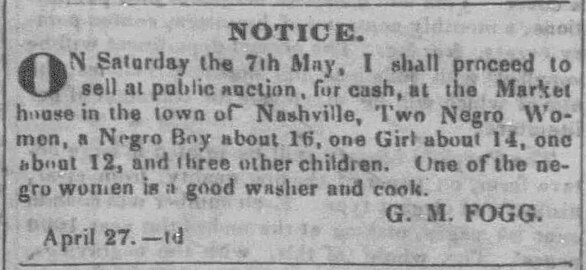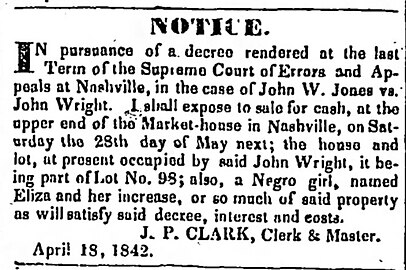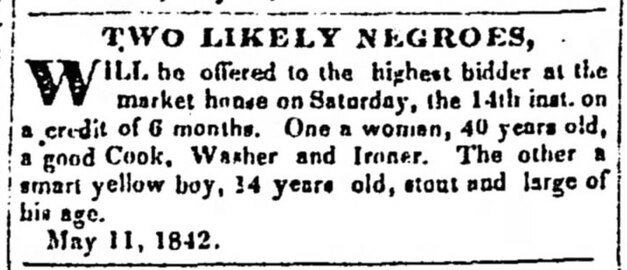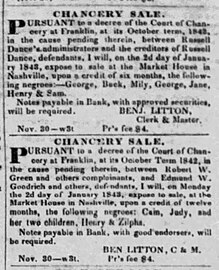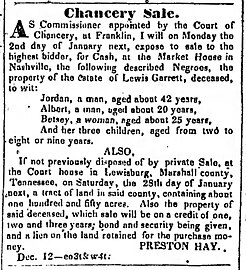
The Hermitage is a historical museum located in Davidson County, Tennessee, United States, 10 miles (16 km) east of downtown Nashville. The 1,000-acre (400 ha)+ site was owned by Andrew Jackson, the seventh president of the United States, from 1804 until his death at the Hermitage in 1845. It also serves as his final resting place. Jackson lived at the property intermittently until he retired from public life in 1837.
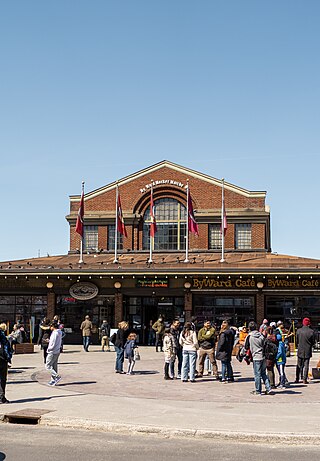
The ByWard Market, is a retail and entertainment district in the downtown core of Ottawa, Ontario, Canada. It is located east of the government and business district. The Market district includes the market buildings and open-air market along George, York, ByWard, and William street.

The Tennessee State Capitol, located in Nashville, Tennessee, is the seat of government for the U.S. state of Tennessee. It serves as the home of both houses of the Tennessee General Assembly–the Tennessee House of Representatives and the Tennessee Senate–and also contains the governor's office. Designed by architect William Strickland (1788–1854) of Philadelphia and Nashville, it was built between 1845 and 1859 and is one of Nashville's most prominent examples of Greek Revival architecture. The building, one of 12 state capitols that does not have a dome, was added to the National Register of Historic Places in 1970 and named a National Historic Landmark in 1971. The tomb of James K. Polk, the 11th president of the United States, is on the capitol grounds.

A slave market is a place where slaves are bought and sold. These markets became a key phenomenon in the history of slavery.
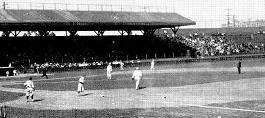
Washington Park was a baseball park in Los Angeles, California, United States. It was primarily used for baseball and was the home of the Los Angeles Angels in the Pacific Coast League (PCL) from its opening on March 28, 1911, until they moved to Wrigley Field late in the 1925 season. The final game at Washington Park was held on September 27, 1925.

2000 Pennsylvania Avenue, formerly known as The Shops at 2000 Penn and Red Lion Row, is a shopping center and eight-story office complex located on Pennsylvania Avenue, NW in Washington, D.C. It forms a busy gateway into the main campus of the George Washington University, which owns the property. As the 2000 Block of Eye Street, NW, the houses were named a DC Landmark and added to the National Register of Historic Places, both in 1977.

The Old Slave Mart is a building located at 6 Chalmers Street in Charleston, South Carolina that once housed an antebellum-period slave-auction gallery. Constructed in 1859, the building is believed to be the last extant slave auction facility in South Carolina. In 1975, the Old Slave Mart was added to the National Register of Historic Places for its role in Charleston's African American history. Today, the building houses the Old Slave Mart Museum.

The City Market is a historic market complex in downtown Charleston, South Carolina. Established in the 1790s, the market stretches for four city blocks from the architecturally-significant Market Hall, which faces Meeting Street, through a continuous series of one-story market sheds, the last of which terminates at East Bay Street. The market should not be confused with the Old Slave Mart where enslaved people were sold, as enslaved people were never sold in the City Market. The City Market Hall has been described as a building of the "highest architectural design quality." The entire complex was listed on the National Register of Historic Places as Market Hall and Sheds and was further designated a National Historic Landmark.
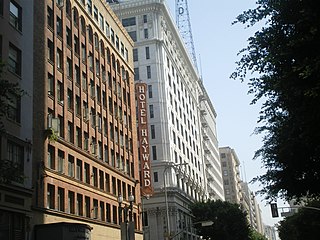
Spring Street in Los Angeles is one of the oldest streets in the city. Along Spring Street in Downtown Los Angeles, from just north of Fourth Street to just south of Seventh Street is the NRHP-listed Spring Street Financial District, nicknamed Wall Street of the West, lined with Beaux Arts buildings and currently experiencing gentrification. This section forms part of the Historic Core district of Downtown, together with portions of Hill, Broadway, Main and Los Angeles streets.

St. Lawrence Market is a major public market in Toronto, Ontario, Canada. It is located along Front Street East and Jarvis Street in the St. Lawrence neighbourhood of downtown Toronto. The public market is made up of two sites adjacent to one another west of Jarvis Street, St. Lawrence Market North, and St. Lawrence Market South. St. Lawrence Market South is situated south of Front Street East, and is bounded by The Esplanade to the south. St. Lawrence Market North is situated north of Front Street East, and is bounded by St. Lawrence Hall to the north.

The Mount Vernon Triangle Historic District is a historic district in the Mount Vernon Triangle neighborhood of Washington, D.C., consisting of 22 contributing residential, commercial, and industrial buildings, and one known archaeological site. The area was once a working class neighborhood for mostly German immigrants and home to semi-industrial enterprises such as a dairy and an automobile repair shop. The Northern Liberty Market that once stood on the corner of 5th Street and K Street NW played a large role in spurring development in the surrounding area as did the streetcars on Massachusetts Avenue and New York Avenue.
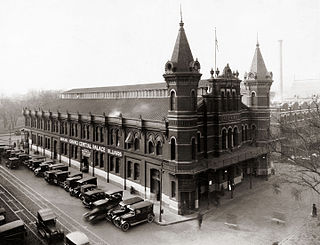
Center Market was a market hall in Washington, D.C. designed by architect Adolph Cluss which operated in Washington, DC from 1872 to 1931. The building was demolished in 1931 to be replaced by the National Archives Building. A market called Center Market had been in operation on the same block of land since 1802. In 1931, the name of Center Market was transferred over to the Northern Liberty Market located a few blocks north.

The Emerald is a mixed-use 40-story skyscraper in downtown Seattle, Washington, United States. The tower includes 262 luxury condominiums, retail space, and amenity spaces on outdoor terraces. It began construction in July 2017 and was completed in October 2020.
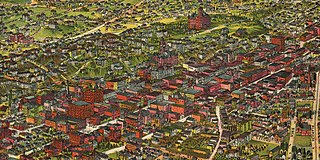
The late-Victorian-era Downtown of Los Angeles in 1880 was centered at the southern end of the Los Angeles Plaza area, and over the next two decades, it extended south and west along Main Street, Spring Street, and Broadway towards Third Street. Most of the 19th-century buildings no longer exist, surviving only in the Plaza area or south of Second Street. The rest were demolished to make way for the Civic Center district with City Hall, numerous courthouses, and other municipal, county, state and federal buildings, and Times Mirror Square. This article covers that area, between the Plaza, 3rd St., Los Angeles St., and Broadway, during the period 1880 through the period of demolition (1920s–1950s).

The Trinity Building, designed by Francis H. Kimball and built in 1905, with an addition of 1907, and Kimball's United States Realty Building of 1907, located respectively at 111 and 115 Broadway in Manhattan's Financial District, are among the first Gothic-inspired skyscrapers in New York, and both are New York City designated landmarks. The Trinity Building, adjacent to the churchyard of Richard Upjohn's neo-Gothic Trinity Church, replaced an 1853 Upjohn structure of the same name. Earlier, the Van Cortlandt sugar house stood on the west end of the plot – a notorious British prison where American soldiers were held during the Revolutionary War.

Central Market was a public market in Downtown Columbus, Ohio. The market operated from 1814 to 1966, was the location of Columbus's first city hall for two decades, from 1850 to 1872. It moved three times, each time into successively larger buildings. The third market building stood the longest time, from 1850 to 1966, when it was demolished as part of the Market-Mohawk Urban Renewal project. North Market remains, the only one left of four public markets that operated in the city.

Vine is an unincorporated community in Wilson County, 12.9 miles (20.7 km) south of Lebanon in the U.S. state of Tennessee. It is located along U.S. Route 231, SR 10, and SR 452. Boundaries for the community are imprecise but typically considered to be the communities of Gladeville to the west, Vesta to the north, Norene to the east, and Silver Hill to the south in Rutherford County. It shares the assigned zip code of 37090 with the rest of southern Wilson County.
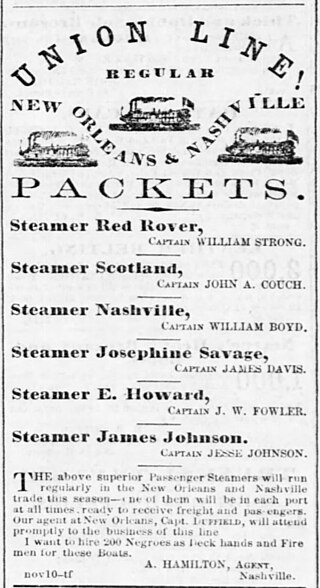
William L. Boyd Jr. was a slave trader, real estate broker, and steamboat captain of Nashville, Tennessee in the United States. In 1883 he was charged with murder in the shooting death of his girlfriend Birdie Patterson.

Slave markets and slave jails in the United States were places used for the slave trade in the United States. Slave pens, also known as slave jails, were used to temporarily hold enslaved people until they were sold, or to hold fugitive slaves, and sometimes even to "board" slaves while traveling. Slave markets were any place where sellers and buyers gathered to make deals. Some of these buildings had dedicated slave jails, others were negro marts to showcase the slaves offered for sale, and still others were general auction or market houses where a wide variety of business was conducted, of which "negro trading" was just one part.


